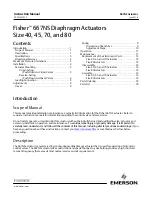
Instruction Manual
D102603X012
667NS Actuator
June 2018
5
If the actuator and control valve body are separate, mount the 667NS actuator on the valve body by following the
procedures in the Actuator Mounting section of this manual.
Actuator Mounting
Direct‐Acting (Push‐Down‐to‐Close) Valves
Refer to figure 1.
1. Screw the stem locknuts all the way onto the valve stem. Put the travel indicator disk, not used with the size 80
actuator, on the locknuts. The concave side of the disk should face the valve.
2. Place the actuator on the valve bonnet.
3. Insert the cap screws and tighten the hex nuts (not shown), securing the actuator to the bonnet. Tighten the cap
screws to the torque shown in table 4.
4. Apply loading pressure to the actuator to retract the actuator stem fully (against the travel stop).
5. With the travel indicator scale attached to the actuator yoke, make a temporary mark on the actuator stem in line
with the top mark on the scale (the mark on the end of the scale that is marked “OPEN”). (The distance from the top
mark on the scale to the bottom mark is equal to the travel of the valve.)
Note
Before turning the spring adjuster on size 70 or 80 actuators, assemble the stem connector around the actuator stem and the
anti‐rotating lug on the yoke. Mark the actuator stem as a visual reference to verify that stem rotation does not occur. Remove the
stem connector before rechecking the bench set.
6. Refer to the actuator nameplate to determine the bench set pressure range of the actuator. Reduce actuator
loading pressure to the lower end of the bench set range. (For size 80, remove the cap screw (key 91, figure 4) and
remove the adjusting screw cover (key 84, figure 4). Rotate the spring adjustor (key 74, figure 2 for sizes 40 and 45;
key 74, figure 3 for size 70; and key 74, figure 4 for size 80) until the mark you made on the actuator stem is in line
with the bottom mark on the travel indicator scale. (Replace the size 80 adjusting screw cover and cap screw when
you have completed the adjustments.)
7. Increase actuator loading pressure to the upper end of the bench range and check to be sure that the mark on the
actuator stem is in line with the top mark on the travel indicator scale.
If the marks are in line,
the actuator is properly bench set.
If the marks are not in line,
the spring is not correct for the specified bench set. It is necessary to use a different spring
or a different bench set.
8. Reduce actuator loading pressure until the mark on the actuator stem is in line with the bottom mark on the travel
indicator scale.
CAUTION
Do not clamp just the tip of either the valve stem or the actuator stem in the stem connector. Incomplete engagement of
the valve stem and/or actuator stem in the stem connector might result in stripped threads or improper operation. Be sure
that the length of each stem clamped in the stem connector is equal to or greater than the diameter of that stem.






































